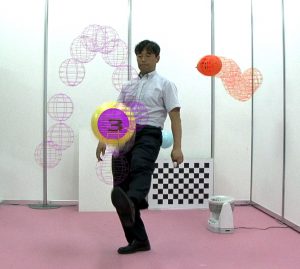Technical details
・Tracking balls with multi-view videos
Balls are automatically extracted and tracked on the basis of video and movement features taken from multi-view
camera videos. A ball’s past position is used to predict its position in the next frame. By limiting the search
range, the tracking accuracy and processing speed can both be improved.
・Calibrating multi-view pan-tilt cameras
To accurately calculate 3D positions and composite CG over video, we improved the accuracy of multi-view camera
calibration by using multiple calibration patterns. We also developed a calibration technique for easily
adjusting the installation of cameras on location.
・Compositing 3D CG in real-time
3D positions of balls are calculated in real-time by triangulation from the information of cameras and 2D
positions of the balls. CG compositing can be accurately performed with the above results and by simulating lens
distortion. Using 3D positions and transition data, each ball’s height and speed are displayable.
NHK STRL
Exhibition content

